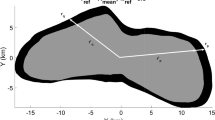Abstract
The computational requirements in the simulations of geopotential estimation from satellite gravity gradiometry are discussed. Fast algorithms for spherical harmonic synthesis and least squares accumulation on a vectorizing supercomputers are presented. Using these methods, in a test case estimation of 2595 coefficients of a degree and order 50 gravity field, sustained program execution speeds of 275 Mflops (87 % peak machine speed) on a single processor of a CRAY Y-MP were achieved, with spherical harmonics computation accounting for less than 1 % of total cost. From the results, it appears that brute-force estimation of a degree and order 180 field would require 537 Million Words of memory and 85 hours of CPU time, assuming mission duration of 1 month, and execution speed of 1 Gflops. Both memory size and execution speed requirements are within the capabilities of modern multi-processor supercomputers.
Similar content being viewed by others
References
Avanzi, G., R. Stolfa and B. Versini, “Solid Earth Aristoteles mission data preprocessing simulation of gravity gradiometer: final Study Report,” ESA CR (P) 2666, Dec. 1988.
Balmino, G. J.P. Barriot and N. Vales, “Nonsingular formulation of the gravity vector and gravity gradient tensor in spherical harmonics,” Manuscripta Geodaetica, Vol. 15, pp 11–16, 1990.
Colombo, O.L., “The global mapping of gravity field with an orbiting full tensor gradiometer,” Proceedings of the XIX General Assembly of the IUGG, Vancouver, Canada, Aug. 1987.
Dongarra, J.J., F.G. Gustavson, A. Karp, “Implementing linear algebra algorithms for dense matrices on a vector pipeline machine,” SIAM Review Vol. 26, No. 1, pp 91–112, Jan. 1984.
Golub G.H. and C.F. van Loan, Matrix Computations, Johns Hopkins Press, 1989.
Gottlieb, R.G., “A fast recursive singularity free algorithm for calculating the first and second derivative of the geopotcntial,” Navigation, Control and Aeronautics Division, NASA Johnson Space Center, 89-FM-10, Houston, Texas, Jul. 1990.
Hasan, D.A., “Analysis of least squares orbit determination accumulation algorithms,” CSR-TM-88-08, Center for Space Research, University of Texas at Austin, Texas, Dec. 1988.
Koop, R. and D. Stelpstra, “On the computation of the gravitational potential and its first and second order derivatives,” Manuscripta Geodaetica, Vol. 14, pp 373–382, 1989.
Lawson, C., et al., “Basic linear algebra subprograms for fortran usage,” ACM Trans. Math. Software, R Vol. 5, pp 308–371, 1979.
Lundberg, J.B. and B.E. Schutz, “Recursion formulas for Legendre functions for use with nonsingular geopotential models,” Journal of Guidance, Control and Dynamics, Vol. 11, No. 1, p 31, Jan. 1988.
Morgan, S.H. and H.-J. Paik (Eds), “Superconducting gravity gradiometer mission,” NASA TM-4091, Vol. 1 and 2, 1989.
NASA, Geodynamics Branch, “Geophysical and geodetic requirements for global gravity field measurements 1987–2000,” Division of Earth Sciences and Applications, NASA, Nov. 1987.
NRC, “Geodesy in the year 2000,” Committee on Geodesy, National Research Council, Nalionai Academy Press, Washington D.C., 1990.
Pines, S., “Uniform representation of the gravitational potential and its derivatives,” AIAA Journal, Vol. 11, no. 11, p 1508, Nov. 1973.
Rapp, R.H. and N.K. Pavlis, “The development and analysis of geopotential coefficient models to spherical hannonic degree 360,” Jour. Geophysical Research, Vol. 90, No. B-13, pp 21885–21911, 1990.
Reed, G.B., “Application of kinematical geodesy for determining the short wavelength components of the gravity field by gravity gradiometry,” Reports of the Department of Geodetic Sciences, Report No. 201, Ohio State University, Columbus, Ohio, Mar. 1973.
Rummel, R. and O.L. Colombo, “Gravity field determination from satellite gradiometry,” Bulletin Geodesique, Vol. 59, pp 233–246, 1985.
Runavot, J.J., “Global measurements of the Earth gravity field using a gradiometric satellite,” Acta Astronautica, Vol. 9, pp 599–607, 1983.
Schrama, E., “Gravity field error analysis: Applications of GPS receivers and gradiometers on low-orbiting platforms,” NASA TM-100769, Goddard Space Flight Center, 1990.
Schutz, B.E., J.B. Lundberg, L.K. White and P.G. Antreasian, “Developments in the simulation of a Geopotential Research Mission,” Proceedings of the AIAA/AAS Astrodynamics Conference, p 323, Minneapolis, Minnesota, Aug. 1988.
Sepers, J., “Requirements for spaccborne gravity gradiometers,” Report of the Delft Tech. University, Faculty of Aerospace Engineering, Dec. 1986.
Sonnabend, D., “A simple GRADIO accelerometer model,” Engineering Memorandum EM 314-495, Jet Propulsion Laboratory, Pasadena, California, Jan. 1991.
Tscherning, C.C., “On the chain rule method for computing potential derivatives,” Manuscripla Geodaetica, Vol. 1, pp 125–141, 1976.
Tscherning, C.C. and K. Poder, “Some geodetic applications of Clenshaw sums,” Bolletino di Geodesia e Scienze Affini, Vol. XXP, No. 4, pp 349–376, 1982.
Tscherning, C. C., R.H. Rapp and C. Goad, “A comparison of methods for computing gravimetric quantities from high degree spherical harmonic expansions,” Manuscripta Geodaetica, Vol. 8, pp 249–272, 1983.
Author information
Authors and Affiliations
Rights and permissions
About this article
Cite this article
Bettadpur, S.V., Schutz, B.E. & Lundberg, J.B. Spherical harmonic synthesis and least squares computations in satellite gravity gradiometry. Bulletin Geodesique 66, 261–271 (1992). https://doi.org/10.1007/BF02033186
Received:
Accepted:
Published:
Issue Date:
DOI: https://doi.org/10.1007/BF02033186




